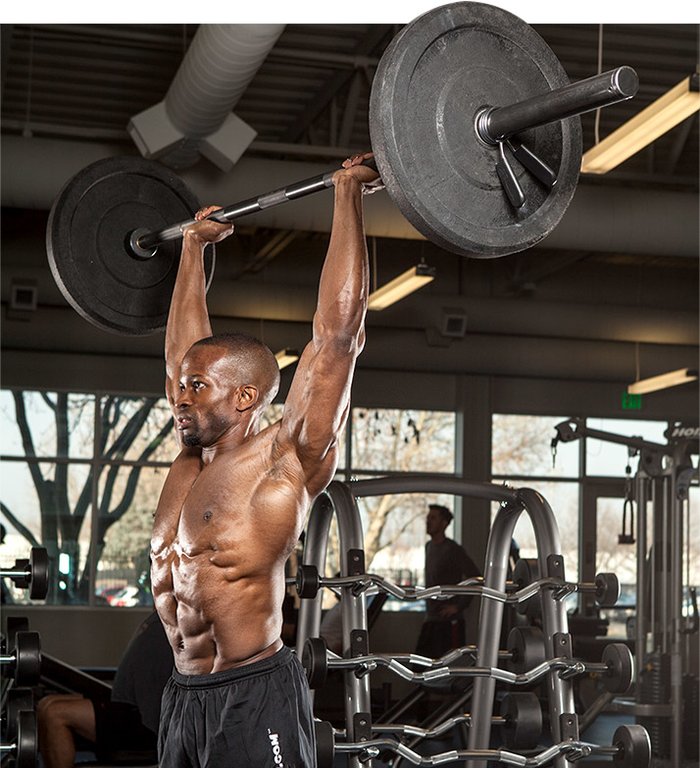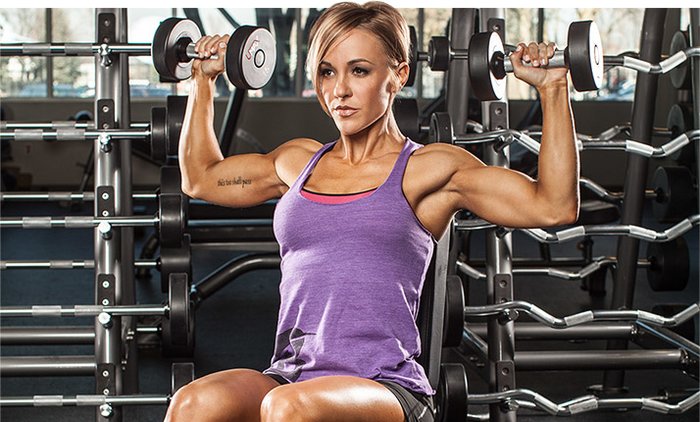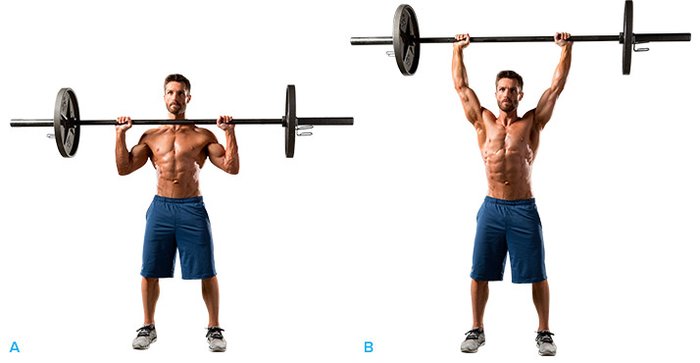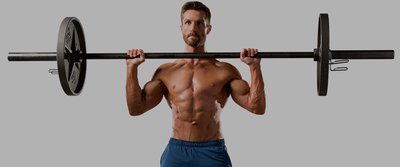The overhead press is a challenging exercise that should be a foundational lift in any upper-body routine. However, most beginners—and a surprising number of seasoned lifters—don't know how to approach this multijoint lift safely and effectively. Let's examine the lift and lay out a solid approach that will lead you to pressing success!
Why Overhead Press?
The overhead press is revered for its brute-strength production and renowned for its seeming simplicity. Just press a barbell, or one of its cousin 'bells, from the top of your chest to its overhead, arms-extended destination. That's the lift in a nutshell, and the juiciest fruits of your overhead labor are unmatched shoulder and upper-back development.
Of course, the brute strength developed by the standing overhead pressing reaches far beyond the shoulders and arms. Full-body engagement builds full-body strength. The standing overhead press also builds the abdominal wall, strengthens the hips, and builds stability through the legs.
But we can't forget the main targets: the shoulders, upper back, and triceps. Search the world over and you won't find another exercise that dramatically develops the shoulders and upper back like the overhead press.
Even though the overhead press is simple to describe, it's actually a relatively technical lift that should be approached intelligently, practiced, and mastered. Here's how to get it done.

The standing overhead press also builds the abdominal wall, strengthens the hips, and builds stability through the legs.
Start With a Self-Assessment
Most lifters don't have direct access to a quality strength coach, so here are a few self-assessments to determine if you're ready to press heavy weight overhead. The fact is, some people's bodies just don't have the raw materials to press overhead without damaging the shoulder joints. Here's how to find out what you can do.
1. Overhead-Reach Test
Stand with either the right or left side of your body facing a mirror, arms resting at your sides. Now, keep both arms straight and raise them overhead. If you got your arms parallel with your ears without your ribcage moving, you've passed this test. If you didn't—if your ribcage moved before your arms were overhead or your arms didn't finish parallel with your ears—you've failed. Don't dive straight into overhead pressing because you don't have the upper-back and shoulder mobility to safely press a bar overhead yet. I'll help you address that after another quick test.
2. Shoulder-Blade Touch Tests
Standing tall with your arms at your sides, reach one arm behind your head and neck and touch the top of the opposite shoulder blade. Do the same thing on the other side. If you can do this on both sides without having to move any body part other than the reaching arm, you're good. If anything else moved, you've failed. That means barbell pressing is out, but you can press with dumbbells and kettlebells.
Now take one arm and reach behind your back and attempt to touch the bottom of your shoulder blade on the same side of the body. Repeat on the other side. Use the same judgment criteria. If you can complete the test without any extraneous movement, you've passed. If not, you fail.

If you fail the shoulder blade tests, you can still do dumbbell overhead presses, and incorporate stretching into your routine.
Next Steps
So, where do you go from here? If you've passed all the tests, you're clear to do barbell overhead presses without concern. If you passed the shoulder-blade tests but failed the overhead reach test, you can press with dumbbells or kettlebells in various positions—1/2 kneeling and tall kneeling, for example—until you've improved. We'll get to those variations a bit later.
If you failed the shoulder-blade tests, you'll want to incorporate these two exercises to improve upper-back mobility:
Cat Camel & Thoracic Extension Rotation
Do 2-3 sets of each exercise for 5-8 reps. If you still can't complete the shoulder-blade test successfully, you may not have the mobility to do overhead barbell presses safely.
When to Overhead Press
While multijoint movements are typically done first in your workout, when to do an overhead press actually depends on the variation. Barbell overhead pressing should be done as your main lift in a workout or as a first-level assistance lift. The lift takes a heavy toll on your nervous system because of its full-body nature and relatively heavy loading.
Dumbbell and kettlebell variations can be done as main lifts—depending on the person and goal—or throughout the training session as assistance lifts and hypertrophy builders.
Choosing the Right Resistance
Form and posture are important pressing variables, especially when it comes to complex standing movements. Those can easily break down as you attempt to move a weight that's too heavy. With this in mind, choose set-and-rep schemes that allow for form and posture maintenance.
Limit barbell overhead press sets to the 3-8-rep range on your heaviest sets. Go below 3 reps and you'll risk breaks in form from optimal pressing posture. Creep above 8 reps and fatigue also burdens the body with poor form.
Dumbbell and kettlebell variations may or may not be done as a main lift, but they can always be done in higher rep ranges. There's smaller risk of form breakdown, and the lighter loading doesn't demand as much from your frame. Press dumbbells and kettlebells in the 5-12-rep range. It's a great range for building accessory strength, improving joint stability, and promoting hypertrophy.
Standing vs. Seated
Though the movement itself is nearly identical whether you're sitting or standing, there are some important differences between doing this movement when standing. The standing barbell press builds more total-body strength than the seated overhead press because it requires more core stability and tension from the hips and legs. Seated presses don't require the same stability because the body is taking stability from the bench. However, you can typically lift a little heavier when seated because of the stability provided by the back rest.
How to Overhead Press
The movement begins in the bottom (start) position. Stand with your entire body tight and rigid. Hold a barbell just above your upper chest, hands slightly wider that shoulder width. Now think of an imaginary straight line drawn from the elbows through the wrists and hands and into the ceiling. Press the bar up along this path as the elbows extend, taking the same path back down to the starting position.
Dumbbells and kettlebells are pressed similarly, with one slight alteration. For some variations, the hands start in a neutral (facing-in) position at the bottom. Start with the hands neutral in the bottom position. Rotating the arms parallel with the ears as you press makes use of the shoulder's entire range of motion. The rest is the same. The elbows extend as the bell is pressed up and back.

Barbell overhead press
Progressing to Barbells Safely
Most of us have some experience with standing overhead presses. However, if you're new to overhead pressing, start with an easier version, such as pressing dumbbells or kettlebells in the tall-kneeling (two knees down) and 1/2 kneeling (one knee down) positions. When you feel you've mastered these with good form, press dumbbells and kettlebells in the standing position. Once you're uber-confident with these versions, grab a barbell.
Start light with barbell overhead pressing and concentrate on form. When beginning, leave 5 reps in the tank at the end of each set and focus intently on each rep. For example, if you choose a weight with which you can do 10 reps with good form, don't do more than 5. If you feel your back arch harder as you press, or you can't finish with your arms parallel to your ears, the weight's too heavy.
Progress by adding 5 pounds to the bar each week. Your body will safely accommodate this hike in load. Strive to do 15-25 total reps, which is the accumulation of all your working sets.
What Else to Lift
Barbell overhead pressing is best paired with pulling exercises like rows and pull-ups, plus shoulder and upper-back mobility exercises. These combos keep the shoulders healthy while improving form that promotes pressing strength.
Unlike a bodybuilding workout, assistance exercises like these are designed to assist a lift's development—that is, to make you stronger in ways that'll aid in the main lift, as opposed to maximally building a muscle. Below, assistance training is planned to train the upper back, shoulders, and core—the areas that improve pressing performance. These exercises are categorized into different levels; the most demanding and impactful exercises immediately follow the press, while secondary and tertiary lifts follow after.
First-Level Assistance Exercises
Choose one exercise and do 3-5 sets of 4-8 reps, not to muscle failure:
- Standing dumbbell or kettlebell overhead press
- Standing single-arm dumbbell or kettlebell overhead press
- Pull-up or lat pull-down

Kettlebell overhead press
Second-Level Assistance Exercises
Choose one exercise and do 3-4 sets of 5-10 reps, not to muscle failure:
- Tall-kneeling or 1/2-kneeling dumbbell or kettlebell overhead press
- Tall-kneeling or 1/2-kneeling single-arm dumbbell or kettlebell overhead press
Third-Level Assistance Exercises
Choose 1-2 exercises and do 3 sets of 4-8 or 5-10 reps, not to muscle failure:
- Bench-press variation (barbell or dumbbells with a flat bench)
- Rowing variation (bent-over barbell, T-bar, seated cable, or dumbbell)
- Barbell or stability-ball roll-out

Reverse-grip bent-over barbell row
Long Live the Overhead Press
The overhead press is a great lift that practically rules the upper-body-training world. Test yourself to ensure you're prepared to press, start with dumbbell and kettlebell presses, and progress to the barbell safely. Then, press your way into big shoulder and upper-body strength glory!

